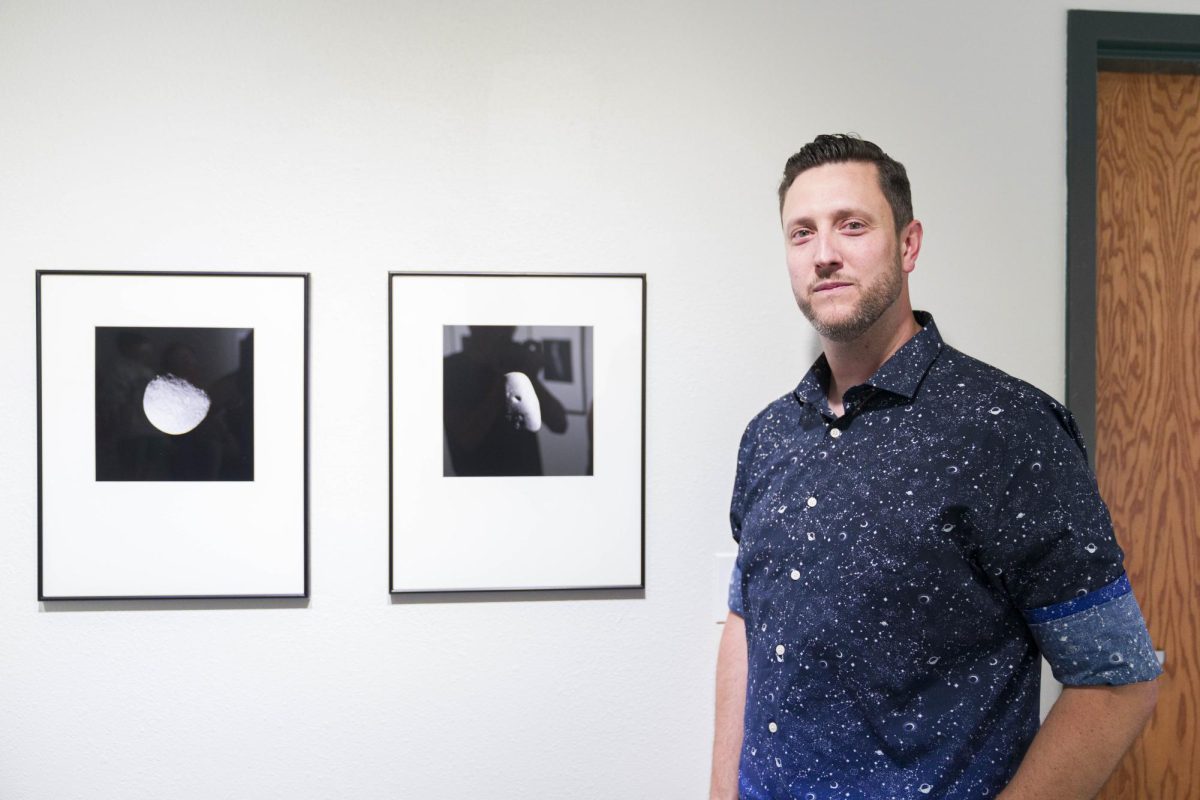Skott Chandler, an associate professor at Black Hills State University, unveiled his new art exhibition at the Ruddell Gallery Aug. 31, displaying a combination of visual, audible and physical depictions of meteorites. The exhibition includes a series of photographs that mimic photos taken by National Aeronautics and Space Administration (NASA). Chandler calls his new collection “Near Misses.” The exhibit plays on fake things that appear real.
Only a select few have been to outer space, and most will never have the opportunity to visit. Because very few have seen space firsthand or ever will, there is a disconnect between reality and fiction regarding space. This was part of the reason Chandler created this series in the first place.
NASA had a project called the Double Asteroid Redirection Test (DART) Mission and it involved impacting asteroids with a satellite to prevent them from hitting earth. After seeing the NASA images, Chandler thought they looked fake, thinking to himself, “so many people probably won’t believe this.”
That thought inspired Chandler to recreate the images himself.
“[I] was looking at how fake that animation looked and then thinking that it is so real we are spending all this money to protect us from something that could potentially happen,” Chandler said. “It feels so fake and insignificant, but the reality of what they were doing was very weighty and existential.”
Chandler has a history of making “fake” photos, such as making bedsheets look like landscapes or recreating twilight zone photos. He wanted to see if he would be able to mimic the real photos of meteorites in a similar way. Media regarding space has a storied history of inspiring conspiracies, including the broadcast of the 1969 NASA moon landing. The mystery of outer space allows exhibits like Chandler’s to invoke questions about the nature of reality.
Chandler started collecting rocks for the project on his walk to and from the BHSU campus and recreated the media of the images that NASA made. He initially started poking fun of the endeavor because if someone does not believe an image when it is real, maybe they will believe a fake.
“I think it’s kind of a visual perception exercise and a critical thinking exercise,” Chandler said.
The process of creating the series involved taking the rocks he collected and taking photos in a blacked-out area of the studio with a mount to hold the rocks. The photos were taken on film and the images that Chandler created appear just as real as the images from NASA, if not more.
Another element that was added to the gallery includes animations and audio elements. Throughout the gallery QR codes are located which allow visitors to pull up 3D gifs of the photographs as well as audio that goes with the exhibit. Headphones are recommended for the best experience.
Inspired by animations that NASA had made, Chandler also wanted to recreate them in the form of gifs. The gifs of the rocks were created using a drill with a mount that he used to slowly spin the rocks capturing the animation.
He started in his house hanging the rocks by strings and after they kept falling, he came up with a solution using the drill. Chandler filmed looking straight down on the rocks while he spun the drill slowly to capture the video.
“When you see it, it feels fake,” Chandler said.
Along with the gifs, he also created complementary audio that was made from the rocks being clanged against each other. With some editing, the rocks create an eerie sound that adds to the illusion of outer space.
In addition to the interactive QR codes, the exhibit includes a wall of facts from NASA, which Chandler included to heighten the perceived reality of the art.
“All of the facts on the wall are actually real,” Chandler said. “Putting a little bit of reality into fiction ups the authenticity.”
By including a dose of reality into the fiction of the art, Chandler hopes to force viewers to think critically about the reality of the exhibit. At the end of the gallery is an artist’s statement that explains the exhibit.
“Information is out there, and you have to be a critical thinker, you have to analyze information because so many people distort things,” Chandler said.
The art in the exhibit solidifies just how easily things can be distorted.
“When people don’t experience something, it’s not real,” Chandler said.
The experiments of NASA hitting asteroids to protect earth is a potentially significant advancement in human capability. Although it may appear to be fiction, the reality that Chandler wanted to convey is that things are not always as they appear.
Chandler earned a Master of Fine Arts degree in photography from the Savannah College of Art and Design in Savannah, Ga., in 2011. He moved to Spearfish, S.D. in 2017 to work at BHSU. Currently, Chandler works in the mass communication program at BHSU teaching various photography and filmmaking courses, while also working on projects such as “Near Misses.”
The exhibit will be up until Sept. 29 in the Ruddell Gallery located on the BHSU campus.


